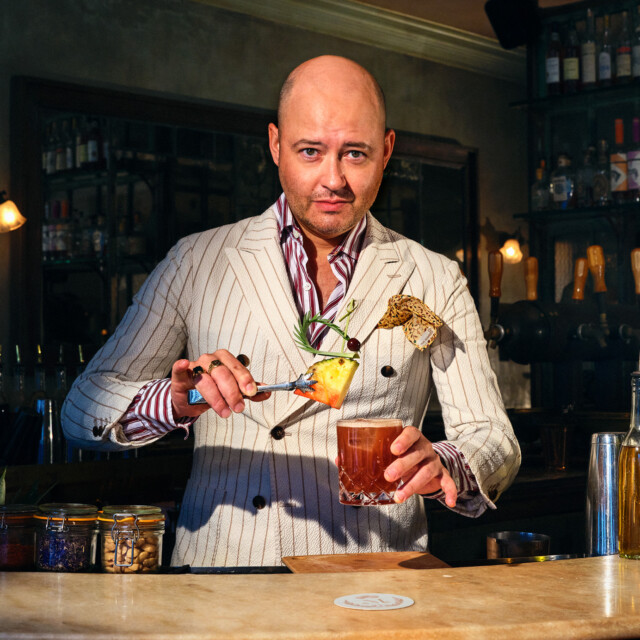For the first few years of my career as a bartender, I was vehemently anti-garnish. At Booker and Dax, we were dogmatic in that everything in the glass needed to be there for a reason, and the reason could not be frivolity. It was a decade ago and Dave Arnold’s pioneering techniques hadn’t taken root in the broader bar world yet, so in order to avoid being pigeonholed as a gimmick program, everything had to be austere when it came to the service of the drinks. The only acceptable garnish was a twist, which would be cut to order from whole fruit. Instagram was in its infancy and there were no influencers mobbing bars to snap pics and capture videos of viral creations. The drinks looked like drinks and tasted wonderful and that was all we cared about.
When Booker and Dax closed, I figured it was time to learn a new style of drink making. I was lucky enough to land a job at the NoMad (yes, every bar I have ever worked at has closed permanently) and suddenly all the rules I used to follow became obsolete. NoMad cocktails were maximalist and exacting. A build could feature a five-, six-, even seven-bottle pickup and include a four-touch garnish. I still have nightmares where I’m stuck building NoMad Pimm’s Cups in perpetuity, the garnish for which involved delicately wrapping a massive bouquet of mint and citrus slices in a mandolined cucumber ribbon and skewering the whole bundle just right so it would balance atop a Collins glass. Despite the difficulty of a few of the more intricate garnishes, every drink we put out at that bar was stunning. Every twist manicured perfectly, every wheel free of seeds, every wedge cut with care, and the most bountiful bunches of mint you’d ever seen. It made me appreciate an approach that was so opposed to my previous camp. I started to not only enjoy making these festively adorned cocktails but seeking them out as well. And for my money, the search for garnish excellence starts and ends at Maison Premiere.
There are very few bars with as clear an ethos as Maison Premiere. You step off the street in Williamsburg, Brooklyn, through the swinging saloon doors, and directly into New Orleans circa 1890. It feels historic and lived in without the overly slick theme park quality of some similar concepts. When you pony up to the bar for an Old King Cole Martini or an Absinthe Colada (a candidate for world’s best drink — I will die on this hill!) the outside world melts away. Much of that sense of immersion comes not just from what’s in the glass but what’s on it.
Maison’s garnish game is legendary in the cocktail community for its precision, beauty, and singular quality. I can tell a Maison cocktail just from a photo of the garnish — they’re really that distinctive. And that uniqueness comes in large part from the influence of William Elliot, resident bon vivant and executive beverage director of Premiere Enterprises, as well as co-author of “The Maison Premiere Almanac.” Recently, I sat down with him in the garden at Maison Premiere to chat about his garnish philosophy, and learn how to develop a garnish ethos of your own.
Adorn for the Room
For William, the garnish doesn’t start with the drink. “[It] entirely depends on where you are working and the space and the concept,” he explains. The team opening Maison made a series of choices around décor and vibe, and the drinks then had to work within that context from both a taste and visual perspective. “We wanted to just lean into the history of drink making and kind of the excessiveness of the style and the form that it looked like in the 1800s and early 1900s. We wanted sort of that cornucopia effect,” he says. “More is more at Maison Premiere.”
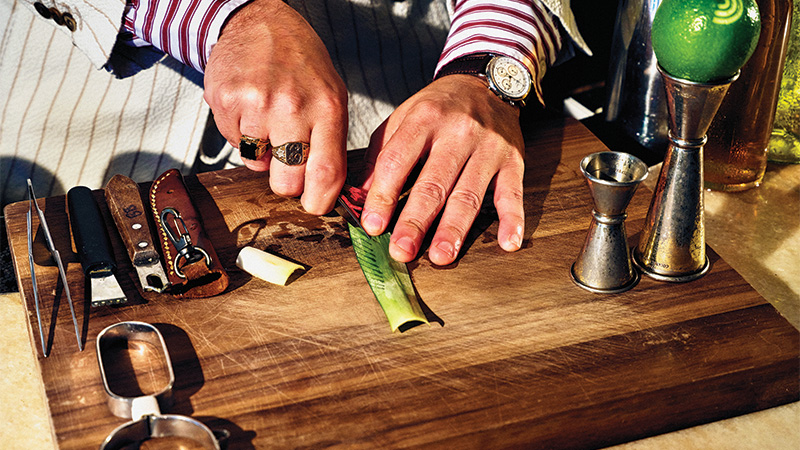
As Maison bartenders conceptualize new garnishes, everything has to look like it could be found in nature. Even if something has been hyper manipulated using a paring knife or a channel knife, William dictates that it should be done in a way that mimics the natural world. Think: pineapple leaves cut to look like palm fronds or a bird’s plumage, lime wedges manicured to look like sedimentary rock or ocean currents, or long strands of orange rind tied into knots that resemble jungle vines.
For Tigre, Premiere Enterprise’s latest project, a windowless Manhattan room bedecked in mirrors and gold that reflect ’80s chic opulence, the garnish vibe could not be more different. Rather than lean to the natural world, William mimics the mindset of what he describes as an “ambitious host at a residential soiree.” Garnishes there, while immaculately cut, lean simple but imposing, like a wide wedge of watermelon or massive slice of pomelo. The idea is that you’re at a house party, and the host wants to really show off this fruit they found. The real story is the room and the company but when you turn to take a sip of the drink you simply can’t ignore the garnish.
Garnish in Practice
Surprisingly, for a garnish-focused program like Maison Premiere, once the general concept for a drink is decided upon — maybe reviving a forgotten classic as a modernized interpretation — the next step is not to go straight to the bells and whistles of ingredient and recipe R&D. “First of all,” William says, “it has to fit around the glass.”
After choosing the vessel, William and team dial in the spec for the cocktail, and when everything is harmonious, all of those components inform the garnish. For example, if a drink was to receive a rinse of house-made black cardamom tincture, “maybe I’ll actually have a black cardamom pod in the garnish,” William says. A classic Maison garnish that follows this methodology is that of the Jungle Bird. With its Campari-stained pineapple wedge, bird’s plumage pineapple frond, and maraschino cherry, it all calls back to the color of the dark, funky rums found inside.
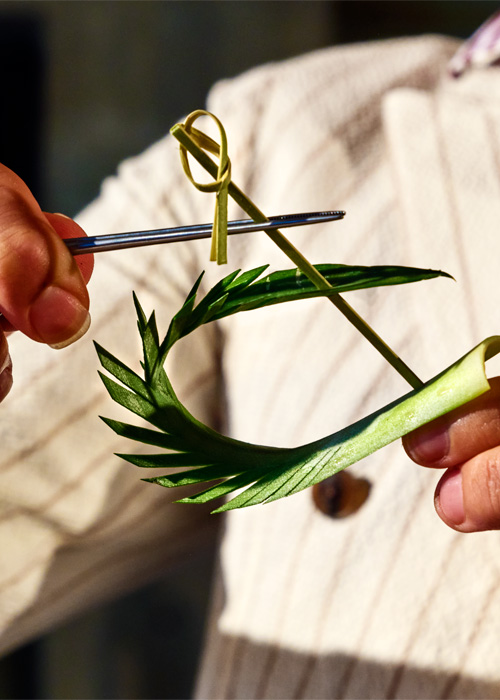
William is just as exacting with his citrus twists as he is with more elaborate garnishes. If he wants a twist in the glass, he’ll often use a coin — a quarter sized round of citrus peel that can be cut in great number from a single piece of fruit — to express oils over the drink, then delicately place a carefully cut larger twist in the glass so it can remain unbent and in its full splendor. If a drink needs orange and lemon oils, the twist expressed second will be more dominant, which will substantially alter the final aromatics of the cocktail; so even that order has been carefully considered. William also engages in the occasional cheeky bout of subterfuge, which he refers to as the “invisible twist.”
“You’ll garnish with an orange twist, but the actual expression might be a lemon or something else,” he says, summing everything up bluntly: “It all matters.”
Making the Cut — at the Bar and at Home
Sitting at the bar at Maison Premiere is akin to the counter experience at an omakase restaurant. The bartenders are constantly cutting, zesting, peeling, grating, and creating art that will eventually adorn glassware, while managing to stay on top of taking orders, pouring water, building drinks, printing checks, and the various other ubiquitous aspects of their job. It’s a delicate balance — one that could easily overwhelm and send service screeching to a halt.
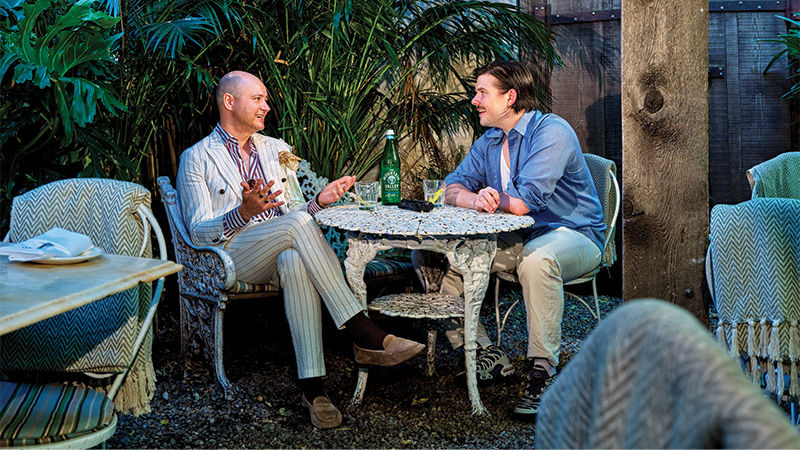
Pre-cutting or preparing in advance can significantly speed the process up. But William’s stance is that, while there are always little things, like having plenty of those micro-zested limes and Campari-dipped pineapples ready to go to streamline service, watching the garnish get made is part of the performance at Maison Premiere. The bartenders simply have to practice until they’re excellent. “Become fearless and fast with peelers, zesters, channel knives, and paring knives,” William says.
Another thing William said in our chat that really stuck out was about originality. “Having your own stance and your own taste is the mark of somebody who’s got some chops and has some skin in the game,” he says. While I decidedly no longer have skin in the cocktail game, I can still drum up a pro-level garnish. So I heeded his advice and put it to practice.
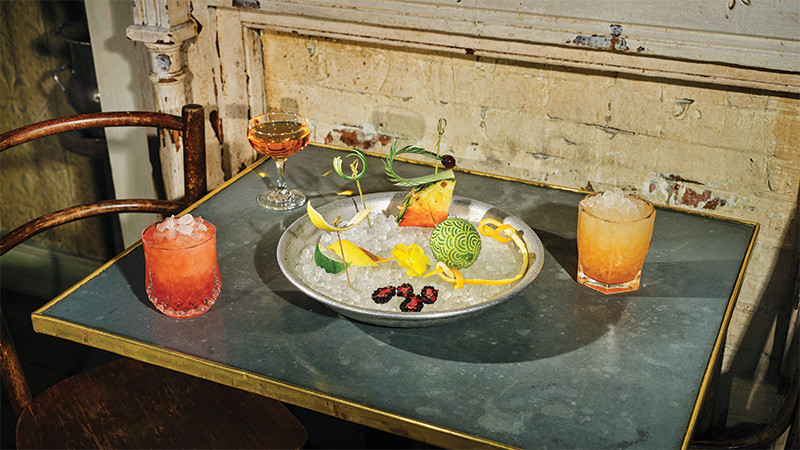
Like William, I took on the challenge of updating a classic that I think doesn’t get nearly enough love — Tom Richter’s brilliant, booze-forward Haitian Divorce, created at the now closed East Village bar The Beagle in 2012. The original calls for aged Haitian rum, mezcal, Pedro Ximinez sherry, Angostura bitters, and both an orange and lime twist as garnish. It’s bold, bracing, complex, and delicious. In my youth, I loved it for its brashness, but I’ve softened considerably since then. My update swaps Haitian for Barbadian rum, adds a measure of Cognac for its soft lusciousness, and changes out the bitters for hibiscus tincture. I may only keep one style of rocks glass at home, but I can still make a cocktail that’s gorgeous and playful with some cheeky knife work. One of my favorite tricks is using a bottle cap to punch a shark bite shape out of a cucumber slice, and I’m plagiarizing myself today and applying it to a surfboard-shaped orange twist for this tropical cross between an Old fashioned and a Manhattan.
Treaty of the North Atlantic
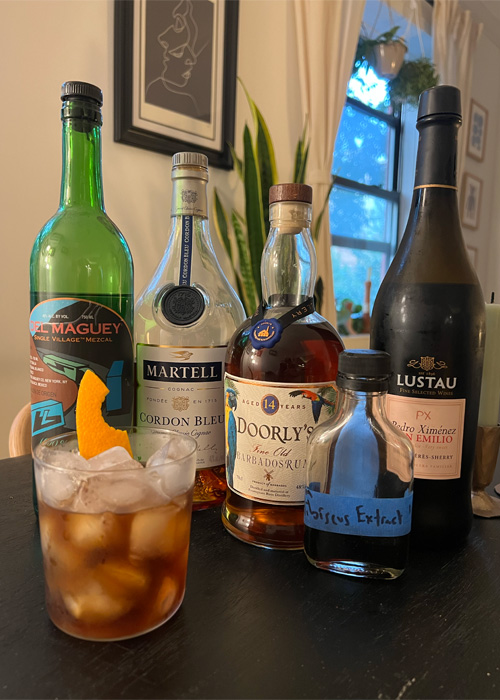
Ingredients:
- ¾ ounce Doorly’s 14 Year, or other good aged Barbadian rum
- ¾ ounce Martell Cordon Bleu, or any good Cognac
- ¾ ounce Del Maguey Tobala, or any good mezcal
- ¾ ounce Pedro Ximinez sherry
- 5 drops hibiscus tincture
- Garnish: shark-bitten orange surfboard; additional orange and lime coin
Directions:
- Add all ingredients to a rocks glass.
- Add ice and stir until chilled and diluted.
- Express the lime coin then the orange coin over the surface of the drink.
- Insert the surfboard, bite side up.
Garnish Directions:
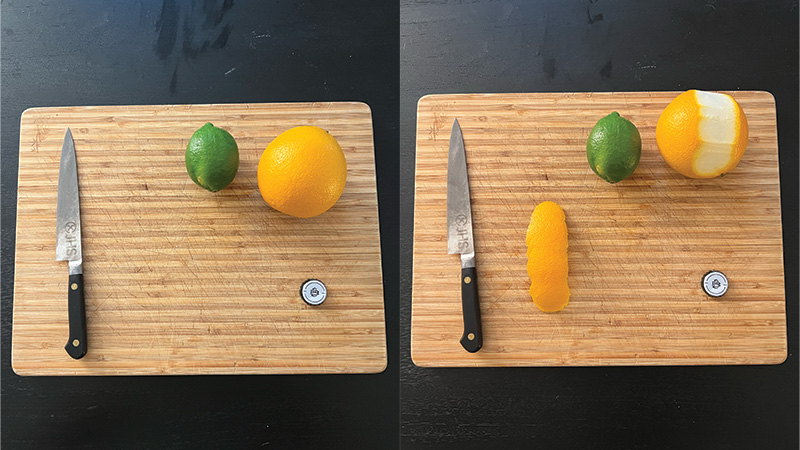
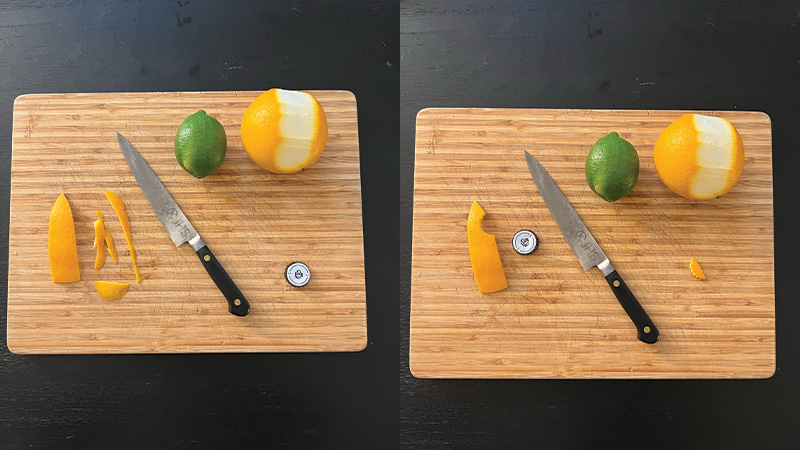
- With a paring knife or Y-peeler, cut a very large twist from an orange.
- With a paring knife, square off one end of the twist then carve the sides into rounded slopes that meet in a point at the other end. It should resemble the outline of a surfboard.
- With a bottle cap, press firmly to punch out the shape of a shark bite from one side of the surfboard.
This story is a part of VP Pro, our free platform and newsletter for drinks industry professionals, covering wine, beer, liquor, and beyond. Sign up for VP Pro now!
